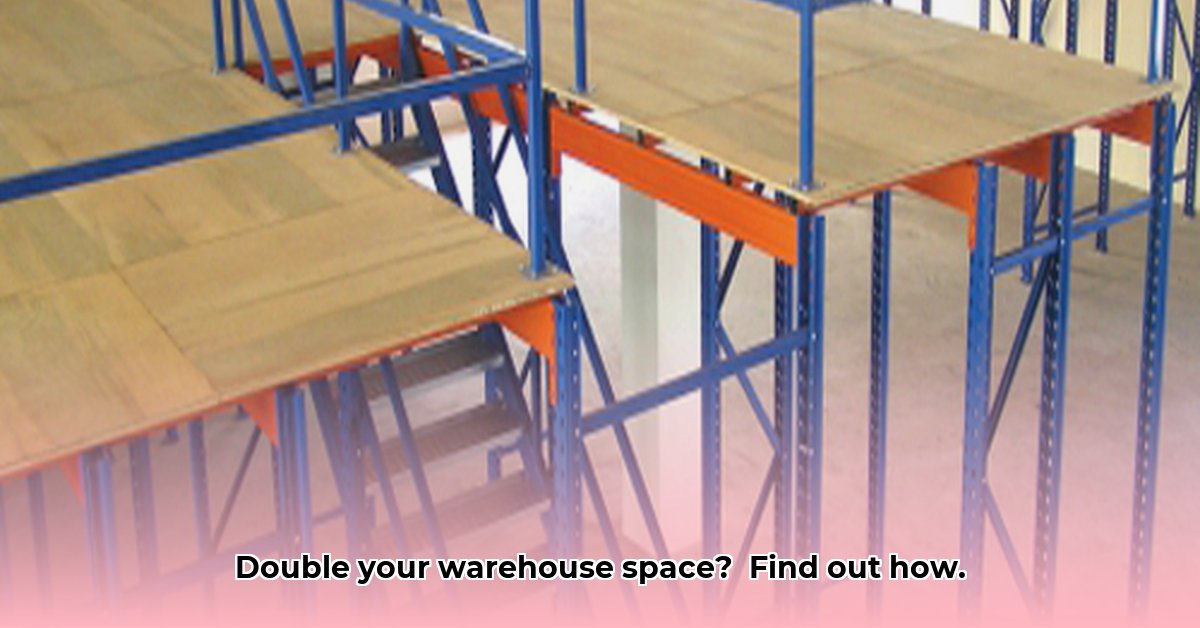Is your warehouse bursting at the seams? A mezzanine floor could be the ideal solution. It’s a cost-effective way to create additional storage space without the expense and disruption of constructing a new building. This comprehensive guide provides a detailed overview of mezzanine floors, covering everything from initial planning and design considerations to safety standards and long-term maintenance. For more information, see this helpful guide on [warehouse mezzanine floors](https://www.wavesold.com/mezzanine-floor-for-warehouse). Discover how to unlock your warehouse’s hidden potential and optimize your storage capacity with a mezzanine floor.
Understanding Mezzanine Floors: A Solution for Expanding Warehouse Storage
Warehouse space is a valuable asset. If you’re struggling with limited space and inefficient inventory management, a mezzanine floor offers a practical solution. By adding an intermediate level within your existing warehouse, you can effectively double or even triple your storage capacity without significantly altering your building’s footprint. Let’s explore how a mezzanine floor can transform your warehouse and enhance your operational efficiency.
Planning Your Mezzanine Floor: Assessing Needs and Optimizing Space
Before diving into the design and construction of a mezzanine floor, it’s crucial to conduct a thorough assessment of your specific storage needs and warehouse layout. Start by evaluating your current inventory and projecting future storage requirements. This will help you determine the appropriate size and weight capacity for your mezzanine floor.
Consider the following factors:
- Storage volume: How much additional storage space do you require?
- Inventory type: What types of goods will you be storing on the mezzanine floor?
- Weight requirements: What is the maximum weight capacity needed to accommodate your stored items and equipment?
- Warehouse layout: How will the mezzanine floor integrate with your existing warehouse infrastructure and workflow?
Design Considerations: Choosing the Right Mezzanine Type and Features
Once you’ve assessed your storage needs, you can begin designing your mezzanine floor. Several types of mezzanine floors are available, each with its own advantages and disadvantages.
- Freestanding Mezzanines: These self-supporting structures offer maximum flexibility and can be easily relocated or modified. They’re ideal for warehouses with limited existing infrastructure or those anticipating future changes in layout.
- Rack-Supported Mezzanines: These mezzanines utilize existing racking systems for support, reducing the need for additional columns and minimizing construction costs. They’re a cost-effective option for warehouses with established racking systems.
- Shelf-Supported Mezzanines: Similar to rack-supported mezzanines, shelf-supported mezzanines integrate with existing shelving units to create an elevated platform. This design maximizes vertical space utilization and provides direct access to stored goods.
In addition to choosing the right type of mezzanine floor, consider the following design features:
- Staircases: Ensure that staircases are strategically placed for easy access and meet all safety regulations.
- Lifts: If you’ll be moving heavy or bulky items to the mezzanine floor, consider installing a lift for added convenience and safety.
- Lighting: Adequate lighting is essential for a safe and productive work environment.
- Safety barriers: Install handrails, guardrails, and safety gates to prevent falls and ensure worker safety.
Safety Standards and Compliance: Ensuring a Safe Working Environment
Safety is paramount when designing and installing a mezzanine floor. Adhere to all relevant building codes and safety regulations to protect your workers and prevent accidents.
- Building codes: Familiarize yourself with local building codes and ensure that your mezzanine floor complies with all requirements for load capacity, fire safety, and accessibility.
- Safety features: Incorporate safety features such as handrails, guardrails, safety gates, and emergency exits to minimize the risk of falls and injuries.
- Fire safety: Install fire suppression systems, smoke detectors, and fire-resistant materials to protect your warehouse and personnel in the event of a fire.
- Load Capacity: Clearly mark weight limits and regularly inspect to ensure adherence.
Installation Process: A Step-by-Step Guide
The installation of a mezzanine floor typically involves the following steps:
- Site Preparation: Clearing the area and ensuring a level surface.
- Structural Support Installation: Installing columns and beams to support the mezzanine floor.
- Flooring Installation: Laying the floor panels or grating.
- Stair and Lift Installation: Installing access points to the mezzanine floor.
- Safety Feature Installation: Adding handrails, guardrails, and safety gates.
It’s highly recommended to hire experienced professionals for the installation process to ensure that the mezzanine floor is built correctly and safely. Communicate clearly with the installation team, confirming timelines, safety protocols, and potential workflow adjustments during installation.
Maintenance and Inspections: Prolonging the Life of Your Mezzanine Floor
Regular maintenance and inspections are essential for prolonging the life of your mezzanine floor and ensuring its continued safety and performance.
- Routine Inspections: Conduct regular inspections to identify any signs of wear, damage, or deterioration.
- Tightening Connections: Check and tighten all bolts and connections to ensure structural stability.
- Cleaning: Keep the mezzanine floor clean and free of debris to prevent accidents and maintain a safe working environment.
Weighing the Pros and Cons: Is a Mezzanine Floor Right for You?
Before making a final decision, carefully weigh the pros and cons of installing a mezzanine floor.
| Pros | Cons |
|---|---|
| Increased storage capacity | Upfront investment costs |
| Improved space utilization | Potential disruption during installation |
| Enhanced operational efficiency | Compliance with building codes and safety regulations |
| Cost-effective alternative to building expansion | Requires careful planning and professional installation |
| Customizable design options | Adaptability limitations once installed without modification |
Ultimately, the decision to install a mezzanine floor depends on your specific needs, budget, and warehouse conditions. By carefully considering the factors outlined in this guide, you can make an informed decision that will optimize your warehouse space and improve your bottom line.
Calculating ROI: Is a Mezzanine Floor a Sound Investment?
To determine the potential return on investment (ROI) of a mezzanine floor, consider the following factors:
- Cost Savings: Calculate the savings from reduced storage costs, improved efficiency, and avoided expansion or relocation expenses.
- Increased Revenue: Estimate the potential increase in revenue from increased storage capacity and improved order fulfillment.
- Tax Benefits: Explore any potential tax benefits associated with mezzanine floor installations.
By conducting a thorough cost-benefit analysis, you can determine whether a mezzanine floor is a sound investment for your business.
Key Takeaways for ROI Calculation:
- Increased Usable Space: Mezzanines can double or triple your available square footage.
- Streamlined Efficiency: Improved workflows lead to increased productivity and revenue.
- Enhanced Safety: Reduced accidents translate to lower insurance costs.
- Avoided Costs: Eliminate relocation or expansion expenses.
Step-by-Step ROI Calculation
Let’s break down the process for calculating the ROI of a warehouse mezzanine installation:
Step 1: Define Project Scope and Objectives
Clearly define the goals of your mezzanine project. Are you aiming to increase storage capacity, improve workflow efficiency, or create a new office space? Having a clear understanding of your objectives will enable you to accurately measure the benefits of the installation.
Step 2: Conduct Detailed Cost Estimation
Create a comprehensive budget encompassing all expenses associated with the mezzanine installation. Consider the following:
- Materials: Steel is the most common material for mezzanine construction, but wood options are also available.
- Labor: Account for the cost of hiring qualified professionals for the installation process.
- Permits and Inspections: Obtain necessary permits and inspections to ensure compliance with local building codes.
- Engineering Fees: Engage structural engineers to assess your warehouse’s structural integrity and ensure the mezzanine can safely support the intended load.
- Contingency: Set aside a contingency fund to cover unexpected expenses or delays.
Step 3: Project Potential Increases in Revenue and Reductions in Costs
Estimate the potential financial benefits of the mezzanine installation.
- Increased Storage Capacity: Determine how much more inventory you can store on the mezzanine floor, and calculate the added value of this increased storage capacity.
- Improved Efficiency: Assess the potential savings from reduced material handling time and labor expenses.
- Reduced Rental Costs: Consider the cost savings from avoiding the need to rent additional warehouse space.
- Safety Improvements: Factor in potential reductions in insurance costs due to improved safety conditions.
Step 4: Calculate Return on Investment (ROI)
Use the following formula to calculate the ROI of your mezzanine floor:
- Total Investment: Sum up all costs from Step 2.
- Annual Net Benefits: Calculate the annual savings (reduced costs) and increased revenue (Step 3).
- Simple ROI: (Annual Net Benefits / Total Investment) * 100 = Percentage ROI
- Payback Period: Total Investment / Annual Net Benefits = Years
By following these steps, you can determine whether a mezzanine floor is a worthwhile investment for your business.
- Glass Tile Shower Ideas to Create a Stunning Bathroom Space - December 7, 2025
- Glass Wall Tile Ideas for Kitchens and Bathrooms - December 6, 2025
- Glass Tile Bathroom: Create a Beautiful, Easy-Clean Space - December 5, 2025










